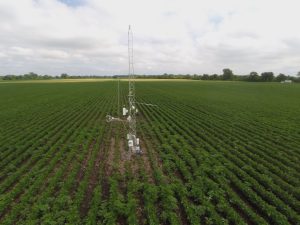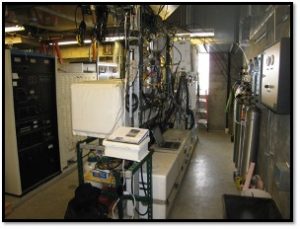The Rosemount AmeriFlux sites are located at the University of Minnesota, Rosemount Research and Outreach Center (RROC) – a 3,500 acre research farm (https://rroc.cfans.umn.edu/). Our eddy covariance sites were established in conventional corn/soy systems in the early 2000s to assess the long-term carbon balance of agricultural systems and to evaluate if practical strategies (i.e. cover cropping, reduced tillage, etc) can help to mitigate carbon losses (https://biometeorology.umn.edu/research/ameriflux).

Photo of AmeriFlux site US-RO6 at the Rosemount Research and Outreach Center illustrating the living mulch kura clover system.
Over the last few years our research has begun to focus on determining the reactive nitrogen (i.e. N2O, NH3) budget of these systems and to experiment with management techniques (i.e. perennial living mulch systems) to reduce reactive nitrogen losses. Globally, about 4% of applied synthetic N leaks into the atmosphere as N2O– a greenhouse gas with a global warming potential that is 270 times that of CO2. Synthetic N fertilizer also leaks into the environment as NH3 , a primary precursor to the formation of atmospheric aerosols which are implicated in adverse human health impacts.
The living mulch system is a modification of corn/soybean rotation that is dominant in the region. It is an attempt to gain the conservation advantages of winter cover crops (protection against erosion, higher infiltration rates), without the challenge of annually planting a cover crop after fall harvest. It uses a perennial legume, kura clover, that lives for decades and spreads by rhizomes. Every spring, we use strip tillage to plant the annual cash crop (corn or soybeans) into the clover. Since the clover is a legume, it also fixes nitrogen, reducing the need for inorganic N fertilizer. We hypothesized that this might reduce both nitrate losses to ground and surface waters,  and also N2O loss to the atmosphere. Initial measurements with automated chambers suggested that the latter may not be the case, but we are now conducting field-scale flux gradient measurements to better understand N2O emission losses in both the living mulch and conventional systems.
and also N2O loss to the atmosphere. Initial measurements with automated chambers suggested that the latter may not be the case, but we are now conducting field-scale flux gradient measurements to better understand N2O emission losses in both the living mulch and conventional systems.
In 2007, we instrumented a 244 m tall communications tower that is operated by Minnesota Public Radio at RROC. The tall tower has multiple eddy covariance systems and tunable diode lasers that have been used to measure isotopes of carbon and water, and more recently, to measure methane, nitrous oxide, and ammonia concentrations. These observations have been used to gain a regional perspective on the carbon and reactive nitrogen budget of the US Corn Belt using eddy covariance and inverse type analyses. Results from these investigations show that N2O concentrations are increasing 0.8 ppb/year within the region and that warm and wet years are contributing significantly to higher N2O emissions.

Photo of the tall tower trace gas observatory at the Rosemount Research and Outreach Station. The tower is being used to measure long-term changes in carbon dioxide, methane, nitrous oxide, and ammonia concentrations and fluxes.

No Comments
Be the first to start a conversation